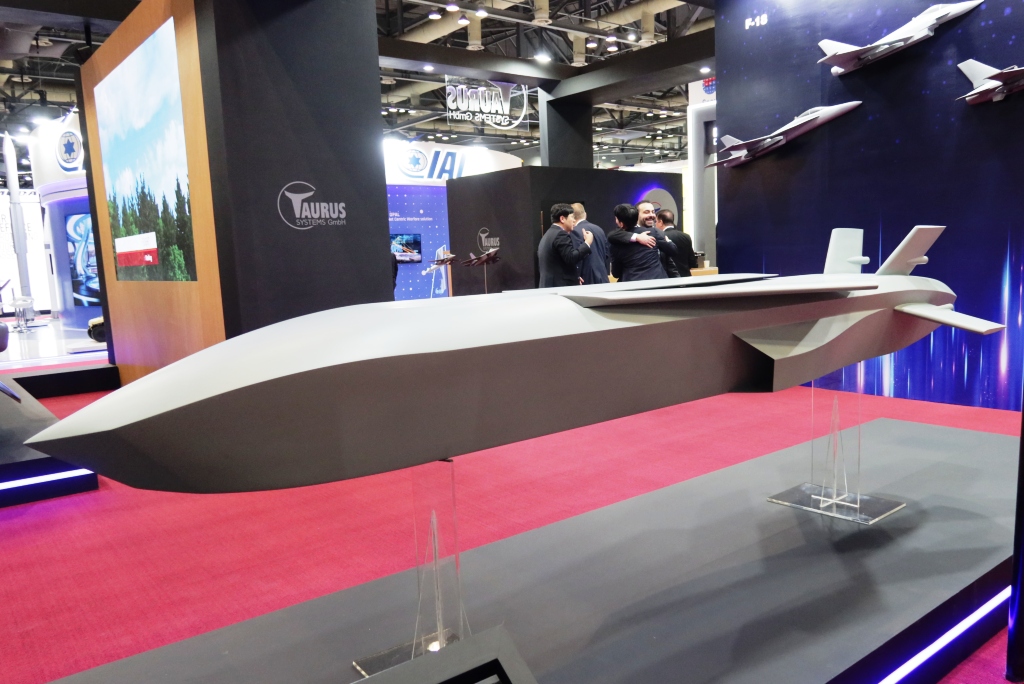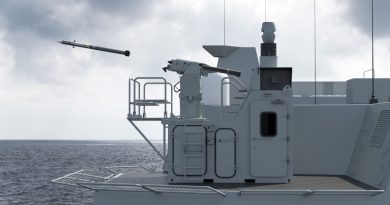
ADEX 2025 – Taurus advances KASOM development
Taurus Systems GmbH, the joint venture between MBDA Deutschland and Saab Dynamics of Sweden, which developed the Taurus KEPD-350 air-launched cruise missile in use by Germany, Spain and South Korea, showcased at ADEX a mock-up of the KASOM, a scaled down version of the original Taurus, providing some more details on the programme
The link between Taurus and South Korea is quite tight, the ROK Air Force being one of the three users of the KEPD-350. Taurus Systems Korea, the local office based in Seoul, is responsible for business development outside Europe, hence it leads the Taurus campaigns in four continents, the technical development being done in Germany.
It was quite obvious therefore to look for a partner when the decision was taken to develop a new missile, the Republic of Korea being of course a potential partner nation. At ADEX 2023 LIG Nex1 and Taurus announced the signature of a Memorandum of Understanding for the development of the MALCM/KEPD350K2 or Medium-Range Air-Launched Cruise Missile, which dimensions will be compatible with the FA-50 fighter attack aircraft produced by Korea Aerospace Industries. At the 2025 edition of the Seoul Aerospace and Defence Exhibition it emerged that the MoU signature did not led to a further step to finalise the cooperation, hence what is not known as KASOM is a fully Taurus programme.
Taurus is talking to several potential customers, EDR On-Line understood, and is gathering the different requirements before freezing the project, which is still in the early definition stage. One of the aims of the new development is to generate a weapon that can fit into the weapons bay of currently designed new aircraft. Apparently an agreement on a standard dimension should have been reached, which is “not far from that of the F-35” EDR On-Line was told. One of the aircraft that might be fitted with an internal weapon bay, which ensures the maintaining of stealth characteristics that would be spoiled should the weapons be carried under the wings, is the Korean KF-21, which Batch 3 aircraft should be fitted with such a bay. The new missile should also be compatible with the F-50, the combat version of the T-50 trainer designed and produced by Korean Aerospace Industries.

A slide showing a comparison between KEPD-350 and KASOM data was shown at the exhibition. The length is reduced by 1,100 mm, the original Taurus being 5,100 mm long versus the 4,000 mm of the KASOM, this being one of the most critical figures when considering the use in a weapons bay. Width is marginally reduced, from 1,080 to 950 mm, while mass reduction is considerable; the new missile has a mass of 907 kg versus the 1,400 kg of the Taurus, an over 35% reduction. Declared ranges are respectively 500+ and 400+ kilometres, while speed remains identical, ranging from 0.6 to 0.95 Mach. The guidance is also heavily based on the previous missile, both having a GNSS, IBN (Image-Based Navigation), TRN (Terrain-Referenced Navigation) navigation suite. That said, technology is advancing and for example IBN will probably be based on colour images, while the current system used black and white pictures. The flight profile will also be similar to that of the KEPD 350, the missile flying at the lowest possible altitude to avoid being detected by radars, a capacity provided by the IBN/TRN navigation system.
Taurus is trying to keep performances as close as possible to the bigger weapon. As seen, the range decrease is 20%, while lethality should also be only marginally reduced. EDR On-Line understood that a tandem shaped-charge warhead is the main option, however should a customer require a lower cost solution, a single shaped charge might also be developed. The warhead will most probably be developed by the Schrobenhausen-based TDW, this MBDA company already providing the Taurus warhead.
It was made clear that Taurus remains open to cooperation, adding partners being relatively easy considering the development status of the programme. At ADEX 2025 EDR On-Line was told that the final design of the KASOM will differ considerably from the mock-up seen in Seoul. No details about the development timeline were provided, but we were told that “a technology demonstrator might fly in two-three years time.”
Photos P. Valpolini


